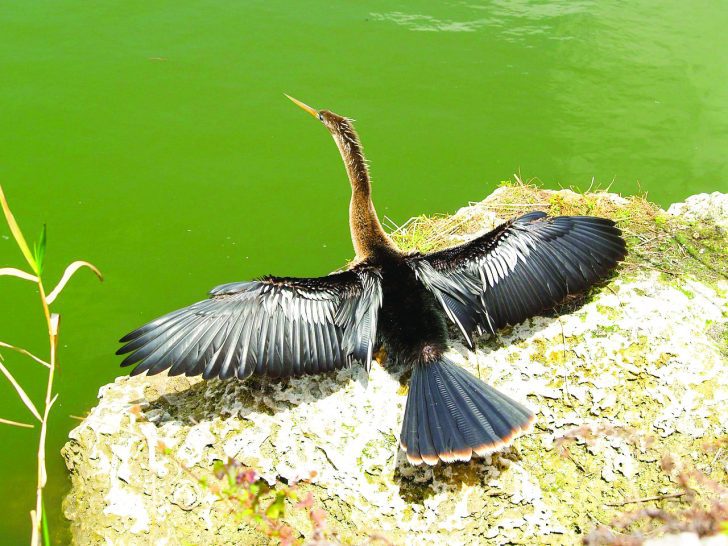
With common names like water turkey, snakebird, and even devil bird, the Anhinga (Anhinga anhinga) is a bird of folklore and mystery. Found year-round in Florida, the Anhinga’s native range includes coastal states from South Carolina to Texas as well as parts of Central and South America. They can live in salt or freshwater environments and are frequently seen in cypress swamps, mangrove-lined bays, and tidal streams—wherever they can find logs or open branches upon which to rest.
Mostly black with a long tail, long neck, and long, pointed bill, the Anhinga is one of two Florida birds adapted to hunting fish underwater. Unlike wading birds that typically pluck small, unsuspecting fish from above the water column, an Anhinga slips into the water quietly and swims to pursue and spear its prey in the side using its sharp, serrated bill. They sometimes consume their prey while underwater, but usually bring it to the surface where they toss it in the air before swallowing it headfirst. In Florida, the Anhinga’s favorite foods include sunfish, bass, killifish, mullet, and mojarra, but they also eat insects and crayfish or other crustaceans.
Anhinga’s typically swim with their body submerged and only their head and neck above the water, hence the nickname snakebird. They can remain submerged for up to a minute as they hunt and are able to dive to depths of 60 feet. This is possible because they lack the gland that ducks and other water birds have for buoyancy and waterproofing, therefore they must spread their wings to dry their feathers in the sun before their next flight.
Anhinga feet are “totipalmate,” which means all four toes are joined with webbing. This puts them in the order Pelicaniformes, along with pelicans, boobies, gannets, tropicbirds, frigatebirds, and cormorants.
Anhinga’s need clean water and healthy waterways to go after their fishy prey—just like anglers! Whenever you’re out on the water, you can protect Florida’s birdlife by retrieving and removing misguided tackle and line from trees and properly disposing of all trash. Together, we can advocate for wetlands restoration and other conservation projects across Florida to protect the places Anhinga’s need to survive and thrive.
